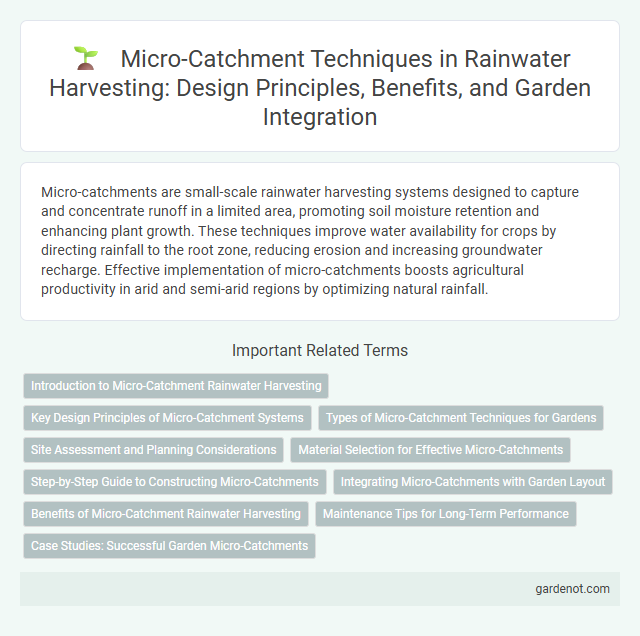Micro-catchments are small-scale rainwater harvesting systems designed to capture and concentrate runoff in a limited area, promoting soil moisture retention and enhancing plant growth. These techniques improve water availability for crops by directing rainfall to the root zone, reducing erosion and increasing groundwater recharge. Effective implementation of micro-catchments boosts agricultural productivity in arid and semi-arid regions by optimizing natural rainfall.
Introduction to Micro-Catchment Rainwater Harvesting
Micro-catchment rainwater harvesting involves capturing runoff from small, defined areas to enhance water availability for crops in arid and semi-arid regions. This technique increases soil moisture through targeted water collection, promoting plant growth and improving agricultural productivity. Effective micro-catchments use structures like contour ridges, bunds, or pits to maximize rainwater infiltration and reduce erosion.
Key Design Principles of Micro-Catchment Systems
Micro-catchment systems for rainwater harvesting optimize water capture by designing small, shaped basins that direct runoff to planted areas, enhancing soil moisture and crop growth. Key design principles include precise contouring to slow water flow, adequate basin size to maximize infiltration without causing erosion, and selection of appropriate catchment areas based on soil type and slope gradient. These principles ensure efficient water retention, minimizing evaporation losses and promoting sustainable agricultural productivity.
Types of Micro-Catchment Techniques for Gardens
Micro-catchment techniques for gardens include key types such as basin, contour trench, and pit systems, each designed to capture and infiltrate rainwater effectively. Basin micro-catchments involve shallow depressions that collect runoff around plant roots, promoting deeper soil moisture and enhancing plant growth. Contour trenches run along the natural land slope to slow water flow, reduce erosion, and maximize infiltration, while pits focus on localized water retention for individual plants or small clusters.
Site Assessment and Planning Considerations
Micro-catchment design requires detailed site assessment, including soil permeability, slope gradient, and rainfall patterns, to maximize rainwater capture efficiency. Planning must account for vegetation type, land use, and drainage characteristics to prevent erosion and ensure optimal water infiltration. Strategic placement of micro-catchments based on topographical surveys enhances water retention and supports sustainable agricultural practices.
Material Selection for Effective Micro-Catchments
Material selection for effective micro-catchments is critical to optimize water retention and infiltration. Porous materials like gravel, sand, or permeable polymers enhance water absorption while preventing surface runoff. Incorporating locally sourced, durable materials ensures sustainability and cost-efficiency in micro-catchment construction.
Step-by-Step Guide to Constructing Micro-Catchments
Constructing micro-catchments involves selecting a suitable site with gently sloping terrain to maximize rainwater capture and infiltration. Begin by marking out planting basins or furrows using simple tools, ensuring dimensions typically range from 1 to 2 meters in length and 0.3 to 0.5 meters in width to optimize water retention. Compact the basin edges to reduce runoff, then plant drought-resistant crops or native vegetation to enhance soil moisture utilization and prevent erosion.
Integrating Micro-Catchments with Garden Layout
Integrating micro-catchments with garden layout maximizes rainwater harvesting by strategically directing runoff to plant root zones, enhancing soil moisture retention. Designing contour basins, swales, or bunds within garden beds captures and stores rainwater effectively, promoting healthier growth and reducing irrigation needs. This method supports sustainable landscaping by optimizing water use efficiency and improving drought resilience in urban and rural settings.
Benefits of Micro-Catchment Rainwater Harvesting
Micro-catchment rainwater harvesting enhances soil moisture retention, directly boosting crop yields in arid and semi-arid regions. This technique reduces soil erosion and improves groundwater recharge by efficiently capturing and utilizing rainfall runoff. Farmers benefit from increased water availability, leading to sustainable agricultural practices and greater resilience against drought.
Maintenance Tips for Long-Term Performance
Maintaining micro-catchment structures involves regular clearing of debris and sediment to ensure unobstructed water flow and optimal soil infiltration. Periodic inspection of bunds and channels for erosion or cracks helps prevent structural failures and water loss. Applying mulch around the catchment area reduces evaporation and enhances soil moisture retention, supporting long-term rainwater harvesting efficiency.
Case Studies: Successful Garden Micro-Catchments
Garden micro-catchments have demonstrated significant increases in soil moisture retention and crop yields by capturing and directing rainwater efficiently. Case studies from arid regions in Kenya and India reveal that micro-catchment techniques, such as contour bunds and zai pits, reduce runoff and improve water infiltration, enabling sustainable agriculture in water-scarce environments. These successful applications highlight the potential for replicable rainwater harvesting systems that enhance food security and ecosystem resilience.
Micro-catchment Infographic

 gardenot.com
gardenot.com